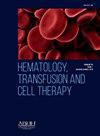Risk factors associated with HIV infection in four large Brazilian blood centers: A multicentric case-control study (2009–2017)
IF 1.6
Q3 HEMATOLOGY
引用次数: 0
Abstract
Background
Strategies to reduce contamination by transfusion-transmissible infections are constantly evolving. Over the years, HIV residual risk has decreased in several countries. However, in Brazil a recent study showed that the residual risk remains substantially higher than in other countries. Continuous surveillance of risk behaviors for infection in donors can help in pre-donation screening to reduce the risk of HIV in blood transfusions.
Methods
This analysis evaluated risk factors related to HIV infection among blood donors from four large Brazilian blood centers located in São Paulo, Rio de Janeiro, Belo Horizonte and Recife, from 2009–2017. A binary logistic model was used to evaluate any association between risk characteristics and behaviors and the occurrence of HIV. The significant variables were included in a saturated model, to which the backward strategy was applied to arrive at the final model. The analyses were carried out using the R program version 4.1.2 and p-value <0.05 was considered significant.
Results
A total of 1507 blood donors were included in the study, 716 were HIV positive and 791 were uninfected controls. Demographics significantly associated with infection were: Male sex, incomplete secondary education, separated/divorced/widowed, and bisexual/homosexual orientation. Behaviors most strongly associated with infection were: workplace exposure, intravenous drugs and men who had sex with other men.
Conclusion
The risk factors identified suggest that the blood donor screening process in Brazilian blood centers does not adequately identify donors at increased risk for HIV and further studies should be carried out to support changes to improve the process.
巴西四个大型血液中心与HIV感染相关的危险因素:一项多中心病例对照研究(2009-2017)
背景:减少输血传播感染污染的策略在不断发展。多年来,若干国家的艾滋病毒残留风险有所下降。然而,在巴西,最近的一项研究表明,剩余风险仍然大大高于其他国家。对献血者感染危险行为的持续监测有助于捐献前筛查,以降低输血中艾滋病毒的风险。方法本分析评估了2009-2017年巴西四个大型血液中心(位于圣保罗、里约热内卢、贝洛奥里藏特和累西腓)献血者中与HIV感染相关的危险因素。使用二元logistic模型来评估风险特征和行为与HIV发生之间的任何关联。在饱和模型中包含显著变量,对其应用逆向策略得到最终模型。分析采用R程序4.1.2版,p值为0.05被认为是显著的。结果共纳入献血者1507人,其中HIV阳性716人,未感染对照791人。与感染显著相关的人口统计数据为:男性、未完成中学教育、分居/离婚/丧偶、双性恋/同性恋取向。与感染最密切相关的行为是:工作场所暴露、静脉注射毒品以及男性与其他男性发生性关系。结论确定的危险因素表明,巴西血液中心的献血者筛查过程不能充分识别出艾滋病毒感染风险增加的献血者,应开展进一步的研究以支持改进这一过程。
本文章由计算机程序翻译,如有差异,请以英文原文为准。
求助全文
约1分钟内获得全文
求助全文
来源期刊

Hematology, Transfusion and Cell Therapy
Multiple-
CiteScore
2.40
自引率
4.80%
发文量
1419
审稿时长
30 weeks
 求助内容:
求助内容: 应助结果提醒方式:
应助结果提醒方式:


